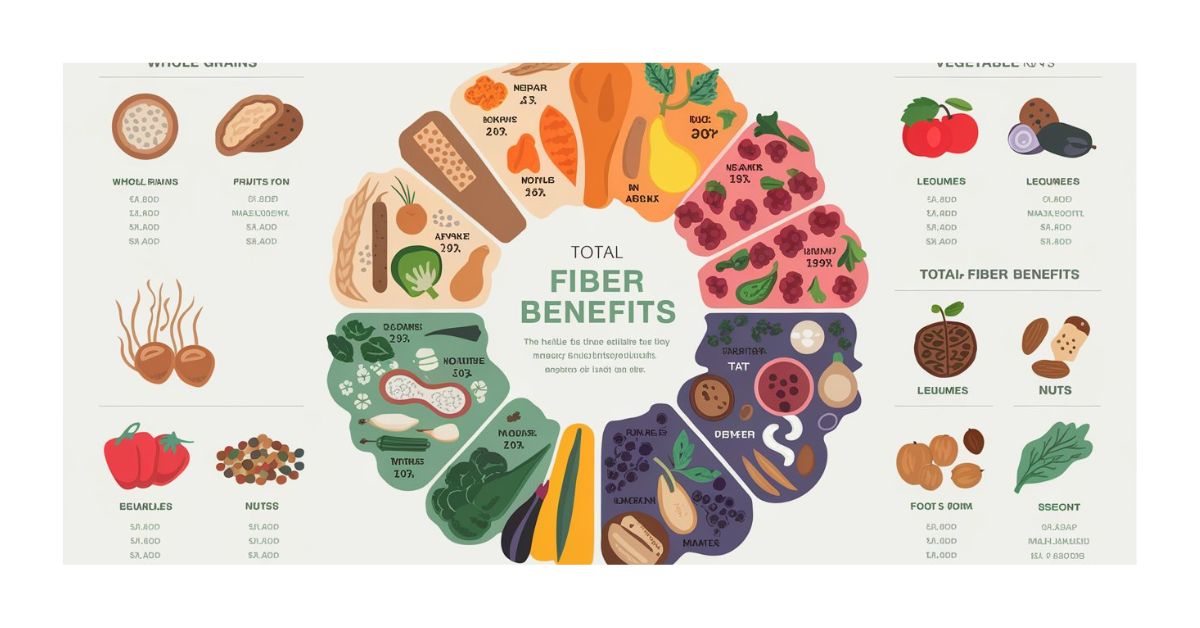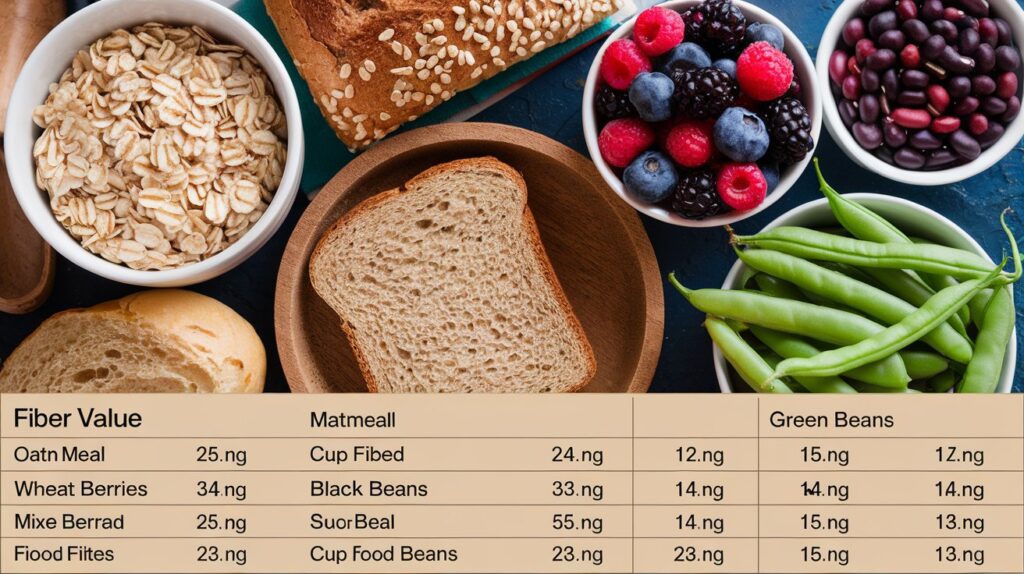
The Comprehensive Benefits of Fiber: Why It’s Essential for Your Health
Fiber, a vital component of our diet, is often overlooked in the hustle of daily life. However, the benefits of fiber extend far beyond mere digestion. In this article, we will explore the multifaceted advantages of fiber and why incorporating it into our diet is crucial for overall well-being.
What is Fiber?
Fiber is a carbohydrate found in plant foods that our bodies cannot digest. Unlike other carbs, fiber passes through the digestive system relatively intact. There are two primary types of fiber: soluble and insoluble. Each type offers distinct health benefits:
- Soluble Fiber: Dissolves in water and can be found in oats, beans, and fruits. It helps lower blood cholesterol and glucose levels.
- Insoluble Fiber: It does not dissolve in water and is found in whole grains, nuts, and vegetables. It aids in moving food through the digestive tract and adds bulk to stool.

1. Promotes Digestive Health
One of the most well-known benefits of fiber is its ability to promote digestive health. A diet rich in fiber helps to prevent constipation by ensuring regular bowel movements. Insoluble fiber adds bulk to the stool, making it easier to pass, while soluble fiber helps maintain a healthy balance of gut bacteria.
Prevention of Digestive Disorders
A high-fiber diet may also reduce the risk of developing various digestive disorders, such as:
- Diverticular disease: Fiber helps prevent diverticulitis, an inflammation of the diverticula in the colon.
- Hemorrhoids: Increasing fiber intake can alleviate symptoms and prevent the development of hemorrhoids.
- Irritable bowel syndrome (IBS): Fiber can help manage symptoms by normalizing bowel movements.
2. Aids in Weight Management
Fiber-rich foods are typically more filling than their low-fiber counterparts. When we consume high-fiber foods, we feel fuller for longer, which can help control hunger and prevent overeating. This satiety effect can be particularly beneficial for individuals looking to maintain or lose weight.
Low-Calorie, High-Fiber Foods
Incorporating more fiber into our diet often means opting for whole, unprocessed foods. Many fruits, vegetables, and whole grains are low in calories but high in fiber, making them ideal for weight management.
- Fruits: Apples, pears, and berries are excellent fiber sources.
- Vegetables: Broccoli, carrots, and Brussels sprouts are packed with nutrients and fiber.
- Whole Grains: Quinoa, brown rice, and whole wheat bread provide significant fiber and essential nutrients. Learn more…

3. Supports Heart Health
In addition to aiding digestion, fiber plays a crucial role in supporting heart health. Studies have shown that a diet high in soluble fiber can lower cholesterol levels, which reduces the risk of heart disease. Learn more…
How Fiber Affects Cholesterol
Soluble fiber binds to cholesterol in the digestive system, preventing its absorption into the bloodstream. Foods high in soluble fiber, such as oats and legumes, are particularly effective in lowering LDL (bad) cholesterol levels.
Blood Pressure Regulation
Additionally, fiber can help regulate blood pressure, contributing to overall cardiovascular health. By maintaining healthy cholesterol levels and blood pressure, fiber reduces the risk of heart disease and stroke. Learn more…
4. Stabilizes Blood Sugar Levels
Fiber, particularly soluble fiber, can help regulate blood sugar levels by slowing the absorption of sugar. This can be especially beneficial for individuals with diabetes or those at risk of developing the condition.
Glycemic Control
Foods high in fiber have a lower glycemic index (GI), meaning they cause a slower, more gradual increase in blood sugar levels. This stabilization can lead to better energy management throughout the day and reduce cravings for sugary snacks.
5. Enhances Nutrient Absorption
A fiber-rich diet not only supports digestion but also enhances the absorption of nutrients. When the digestive system functions optimally, the body can better utilize essential vitamins and minerals from the foods we consume.
Beneficial Nutrients
Fiber-rich foods are often packed with beneficial nutrients, including:
- Vitamins: Many fruits and vegetables are rich in vitamins A, C, and K.
- Minerals: Whole grains provide essential minerals like iron, magnesium, and zinc.
- Antioxidants: Many high-fiber foods contain antioxidants that protect the body from oxidative stress.
6. Reduces the Risk of Chronic Diseases
A diet high in fiber has been linked to a lower risk of several chronic diseases, including:
- Type 2 Diabetes: Increased fiber intake is associated with a reduced risk of developing type 2 diabetes.
- Colorectal Cancer: Research suggests that a high-fiber diet may protect against colorectal cancer.
- Cardiovascular Disease: As previously mentioned, fiber contributes to heart health, reducing the risk of cardiovascular issues.
7. Supports Healthy Skin
Fiber can even have a positive impact on skin health. A diet rich in fiber helps flush out toxins from the body, leading to clearer skin. Additionally, certain high-fiber foods, such as fruits and vegetables, are rich in vitamins and antioxidants that promote healthy skin.
Hydration and Skin Elasticity
Moreover, fiber helps maintain hydration levels, which is essential for skin elasticity and overall appearance. Foods with high water content, like cucumbers and oranges, are often high in fiber, contributing to both hydration and fiber intake.
Incorporating More Fiber into Your Diet
To reap the numerous benefits of fiber, it’s essential to incorporate more fiber-rich foods into our daily diet. Here are some tips for increasing fiber intake:
- Start Your Day with a High-Fiber Breakfast: Choose oatmeal or whole-grain cereal topped with fruits.
- Snack Smart: Opt for fruits, nuts, and whole-grain crackers instead of processed snacks.
- Add Legumes to Your Meals: Beans and lentils can be added to soups, salads, and main dishes.
- Choose Whole Grains: Switch from white bread and pasta to whole grain alternatives.
Conclusion
In conclusion, the benefits of fiber are numerous and impactful, ranging from improved digestive health to reduced risk of chronic diseases. By making a conscious effort to include more fiber-rich foods in our diets, we can enhance our overall health and well-being.
Fiber is not just a dietary addition; it’s an essential component for a healthier life. We encourage everyone to explore the many delicious and nutritious options available to boost fiber intake.
FAQs
1. What is fiber?
Fiber is a type of carbohydrate found in plant foods that our bodies cannot digest. It is essential for digestive health and is classified into two main types: soluble and insoluble fiber.
2. How does fiber promote digestive health?
Fiber helps prevent constipation by adding bulk to stool and promoting regular bowel movements. It also supports a healthy balance of gut bacteria.
3. What are the different types of fiber?
There are two primary types of fiber:
- Soluble Fiber: Dissolves in water and can be found in oats, beans, and fruits. It helps lower blood cholesterol and glucose levels.
- Insoluble Fiber: It does not dissolve in water and is found in whole grains, nuts, and vegetables. It aids in moving food through the digestive tract.
4. Can fiber help with weight management?
Yes, fiber-rich foods tend to be more filling, helping to control hunger and prevent overeating, which can assist in weight management.
5. How does fiber support heart health?
Fiber helps lower cholesterol levels and regulate blood pressure, reducing the risk of heart disease and stroke.
6. Is fiber beneficial for diabetes management?
Absolutely! Fiber, especially soluble fiber, can help stabilize blood sugar levels by slowing sugar absorption, making it beneficial for those with diabetes.
7. How can I increase my fiber intake?
To increase fiber intake, opt for whole grains, fruits, vegetables, and legumes. Start with high-fiber breakfast options, snack on fruits and nuts, and incorporate beans and lentils into your meals.
8. What are the risks of low fiber intake?
Low fiber intake can lead to digestive issues such as constipation, increase the risk of chronic diseases, and hinder nutrient absorption.
9. How much fiber do I need daily?
The daily recommended intake of fiber is about 25 grams for women and 38 grams for men. However, individual needs may vary.
10. Are there any side effects of consuming too much fiber?
Excessive fiber intake can lead to digestive discomfort, including bloating and gas. It’s important to increase fiber intake gradually and drink plenty of water.

Leave a Reply